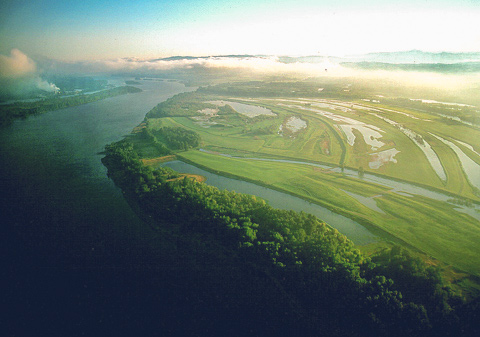On the night of 4 November 1805 the expedition camped near a pond now called Post Office Lake, about 4½ miles south—up river—of Bachelor Island. The next morning a weary, groggy Clark complained that he “could not Sleep for the noise kept by the Swans . . . Geese, white & black brant, Ducks . . . & Sand hill Crane. They were emensely numerous and their noise horrid.” He may well have been speaking for most of the other men in the party.
Nevertheless, the party piled into their canoes again at sunrise. Nine miles downriver, near today’s Ridgefield, they passed “an Isld. Covered with tall trees & green briers Seperated from the Stard. Shore by a narrow Chanel.” The captains were told by some Cathlapotle Indians that the channel (immediately beyond the trees growing on the island in the foreground) was a river called Cah-wâh-na-hi-ooks—a Chinookan word for “enemies”—which entered the Columbia River at the downstream end of today’s Sauvie Island (the captains’ “Wappetoe Island).
The River Cahwâhnahiooks received its modern name, Lewis River, not in honor of Meriwether Lewis, but rather for a man named Adolphus Lee Lewes[1]Adolphus Lee Lewes (1821-1856) was the half-breed son of John Lee Lewes, one of some two dozen chief factors or “mercantile agents” of the Hudson’s Bay Company. In 1839 Adolphus … Continue reading–no relation to Meriwether. Lewes established himself as a pioneer landowner in the new 640 acres of free “donation land” on the lower Cahwâhnahhiooks River.
Ridgefield, hidden by the thin cloud at upper right, is headquarters for the 4,600-acre Ridgefield National Wildlife Refuge, which harbors more than 180 species of birds. “This is certainly a fertill and a handsom valley,” Clark observed as he passed through the scene in this picture, “at this time Crouded with Indians.” However, the camp that night, twenty-three miles farther on, was “the first night which we have been entirely clear of Indians Since our arrival on the waters of the Columbia River.”
On the expedition’s return up the Columbia trek, breasting the rising spring freshet, they camped near here again on 29 March 1806. This time the explorers remarked not on the birds, but on the reptiles that they observed on their “Wappetoe Island.” “The garter snakes are innumerable, & are seen entwined arround each other in large bundles of forty or fifty lying about in different directions through the praries.” Apparently they were unaware that this is an annual mating ritual among certain species of reptiles. The description is creepy enough to divert the most dedicated naturalist to drop his scientific objectivity.
From Discovering Lewis & Clark from the Air
Photography by Jim Wark
Text by Joseph Mussulman
Reproduced by permission of Mountain Press
Ridgefield National Wildlife Refuge is a High Potential Historic Site along the Lewis and Clark National Historic Trail managed by the U.S. National Park Service. In addition to wildlife viewing, the Cathlapotle plankhouse re-construction is also located here.
Notes
| ↑1 | Adolphus Lee Lewes (1821-1856) was the half-breed son of John Lee Lewes, one of some two dozen chief factors or “mercantile agents” of the Hudson’s Bay Company. In 1839 Adolphus entered the employ of the HBC as a surveyor and clerk for General Service in the Columbia Department. |
|---|



